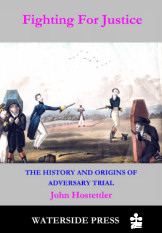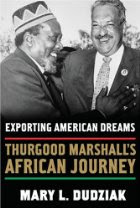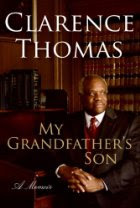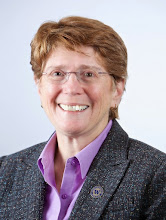
A few years ago, I wrote a short post about Distorting the Law: Politics, Media, and the Litigation Crisis, by William Haltom and Michael McCann (KF380 .H358 2004 at Good Reads). At that time, I just quoted the publisher's description. Now I've read the book and I'd like to say a little more.
The book provides an interesting analysis -- based on heaps of research -- of the national debate on tort reform and the so-called litigation crisis. Unfortunately for the general reader, it's written in a dense, academic style. I'm a pretty good reader, familiar with law (although not with academic political science), and I found the book pretty challenging. But, as I said, it's interesting. One help, if you want an overview, is the authors' website, www.lawslore.info, which includes a chapter-by-chapter summary. My own (selective) summary follows.
Chapter One, "The Social Production of Legal Knowledge," discusses how Americans come to "know" things about the civil legal system. It uses the example of one case, showing how the case became a "fable" told by tort reformers with little link to what actually happened. According to the fable, a jury awarded a woman $1 million because her psychic powers were damaged by a CAT scan. In fact, her claim was for headaches, pain, and inability to work stemming from a dye used to prepare for a CAT scan she never had. Although a jury did award her damages, the trial judge set aside the verdict and ordered a new trial and later the case was dismissed and the dismissal was affirmed on appeal. So the fable about runaway juries and windfall damages turns out to be about a plaintiff who didn't get a dime.
Chapter Two, "Pop Torts," goes further into the creation and wide dispersal of anecdotes depicting corporations as the victims of greedy trial lawyers and plaintiffs. The anecdotes build on themes of individual responsibility and distrust of lawyers.
Chapter Three, "In Retort: Narratives versus Numbers," explores the way that academics have responded to the claims of tort reformers -- and why the response hasn't had much impact in the debate. The public has come to believe that there's a litigation explosion, that it's too easy to sue, that juries like to stick it to corporations -- but "the impressive array of data that social scientists have marshaled to discredit the legal lore disseminated by tort reform polemicists" (p. 108) doesn't reach the public.
Our primary point ... is that the studies we have recounted here are, by standards of ordinary discourse, unfamiliar and difficult, and, by standards of opinion leaders, esoteric and tedious. Such sophisticated forms of knowledge simply do not translate into modern mass communication.
[This] is not intended as a critique of social scientific endeavors. ... [W]e realize that our own academic product suffers from many of the same professional liabilities that we identify in the work of others. But that is our point. ...
We do not intend to suggest ... that social scientists cannot contribute effectively to mass cultural knowledge. Sophisticated research can be used in service of mass influence, but to do so it must transcend narrow academic conventions. ... [S]cholars need to connect their powerful debunking efforts to more artful narratives that illustrate the complexities of tort law practice, highlight its implications in experiential terms, link tort law remedies to our nation's deepest values, and yet nurture the aspiration of rendering these legal processes ever more accessible, just, and democratic.
pp. 109-10.
The next chapter discusses the tactics ATLA (now
American Association for Justice) has used in response to the tort reform movement -- focusing on lobbying and legal challenges, not public opinion.
Chapter Five examines the media's treatment of tort issues. Journalistic standards -- what makes a story newsworthy -- contribute to distorted views of the legal system. For example, a million-dollar verdict is more newsworthy than a $50,000 verdict or a dismissal, so it's no surprise that big verdicts get a lot of coverage and many people believe that huge verdicts are much more common than they are.
Chapter Six continues this theme using the specific example of the notorious McDonald's "hot coffee" case. I had never read as much detail about the case -- the facts, the claims, the evidence, and so on. Haltom and McCann analyzed coverage of the case in newspapers and found, for instance, that there was a lot more coverage of the initial verdict (with its startling and newsworthy $2.7 million in punitive damages) than there was of the judge's reduction of the punitive damages and the later settlement of the case. And there wasn't much coverage of why the jury awarded punitive damages: because McDonald's hadn't done anything about 700 previous complaints about scalds from coffee; the jury thought that the way to get the attention of the huge corporation was to award punitive damages -- the huge number was about the amount of profit McDonald's made from coffee in two days.
Chapter Seven looks at the coverage of tobacco litigation.
A couple of the authors' observations from their concluding chapter, "Law Through the Looking Glass of Mass Politics":
[N]ews coverage almost entirely overlooks the limits on the practical options available to injured citizens. It obscures the fact that most lawsuits for products liability, medical malpractice, and workplace injuries represent a last (not a first) resort for many citizens lacking sufficient personal resources to purchase adequate private insurance, absorb damages, cover health costs from injuries, survive unemployment, and the like. Indeed, the primary example of plaintiffs in this book -- retirees like Stella Liebeck whose low-wage job provided scant savings, a meager retirement fund, and inadequate health care coverage; widows and widowers of smokers or workers subjected to asbestos; women victimized by unsafe, unethically marketed contraceptives, high absorbency tampons linked to toxic shock syndrome, and products like silicone breast implants promising to enhance esteem or appeal; low-income citizens who cannot buy high-priced products, live in environmentally unsafe areas, and labor in unsafe workplaces -- are hardly atypical of those who turn to legal action for lack of alternatives in addressing injuries, diseases, and disabilities. It is worth noting in this regard that the impersonal, abstract stereotype of the "litigious plaintiff" masks the racial, gendered, and class features of those claimants, claims, and contexts that it commonly targets. Likewise, the stigma of excessive litigation indirectly undermines legal mobilization strategies by broader rights-based movements ... lacking clout in other political arenas. ...
It follows, finally, that the prevailing forms of media-supported knowledge about hyperlexis deflect attention from issues of collective responsibility and the failures of "democratic" government institutions to address adequately the issues of risk and harm in contemporary life.
pp. 288-89 (emphasis in original)
Bonus: Readers interested in this subject will find lots of good leads in the bibliography.






















